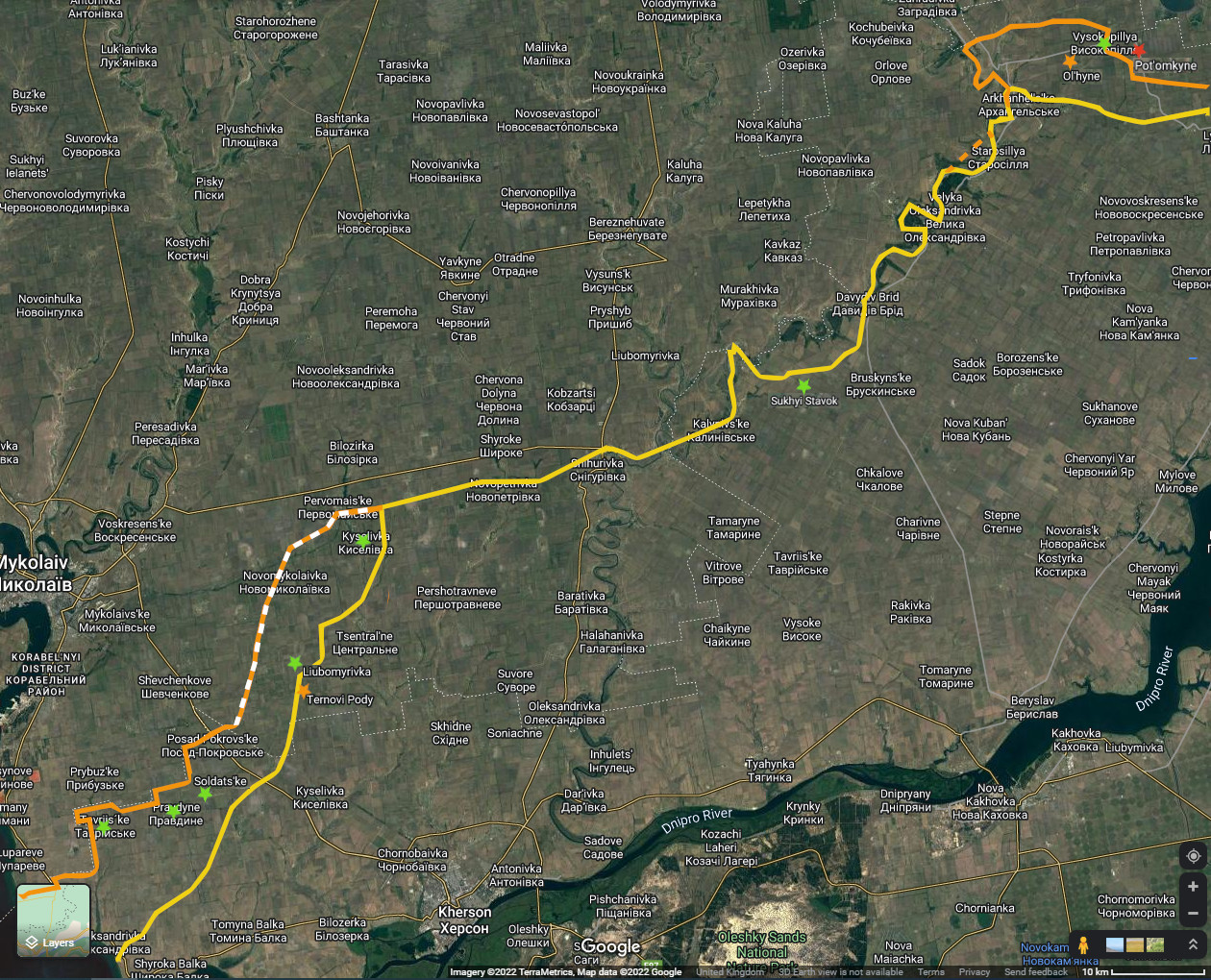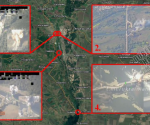The Ukrainian Kherson counteroffensive that was over before it began, or never was – again
Incredibly, even on the fourth day after it had been spoken into existence, some OSINT aggregators and their regurgitators on social media were still claiming that there was such a thing as a Ukrainian counteroffensive into the Kherson Oblast.
In truth, there had barely been any such thing. In fact, it suits better to say that the Russians played “whack-a-mole”, where in place of a mallet they used artillery to bop Ukrainian heads whenever up they popped.
The map below tells it bluntly like it is. The yellow border is the front line as reckoned by liveuamap.com (with its Ukrainian bias); the Russians hold the south and east. The orange border is what the Russians appear to claim additional to what liveuamap.com allows (see the previous article, Some Quietly Stated Surprises Despite General Russian Silence In Special Military Operation). The hatched white and orange border is the same thing as an orange one, except that its exact position can’t be precisely discerned in the most recent Russian MoD map. The dotted orange border is a possibility, but again, it is not precisely discernible.
The green stars to be seen on the map represent settlements that the (prima facie) pro-Russian OSINT-mongers claimed had been captured by the Ukrainians [there are no such like Ukrainian sources because of a Kiev regime ban]. The orange stars represent settlements which the Russian Ministry of Defence mentioned in a briefing as having been defended from Ukrainian attack; for their part, the OSINT dealing “expertise” claimed the same places as captured by the Ukrainians. The red star represents a settlement that the General Staff of the Ukrainian Armed Forces admitted was being attacked by the Russians (via liveuamap.com).
By 31st August, by many accounts, and so by the third day after the commencement of the debacle, the Ukrainians had been driven back from all points of their extremely limited advance. Some OSINT mongers clung to their click-bait by claiming that Andreevka and Lozovoye were two settlements still “firmly” held by the Ukrainians, as if they had been won from and were being stubbornly denied to the Russians. However, the truth was that these two settlements had been on the Ukrainian side of the line on the 29th – information that these operatives, further exposing themselves as bad actors, could not have failed to be aware of. Indeed, it’s true to say that the Ukrainian non-counteroffensive appeared much more terrible than it was thanks to the aiding and abetting “pro-Russian” OSINT boys who somewhat panicked their own audience. Otherwise, if imaginations had not been suitably agitated to see an expansive venture, who could reasonably allow that the Ukrainians – who never advanced more than a couple of miles in grossly inadequate numbers of narrow front widths along a combined one of more than 100 miles before being pummelled to a halt and made to retreat – had mounted anything that deserved to be called a “counteroffensive”.
Above all else that was wholly inadequate was the failure to deal with the advantage of artillery and a system of execution for a devastating firepower superiority, as per the Russian military doctrine, that could only lead to one eventuality: a crushing Ukrainian defeat. The Russian MoD makes the casualty† list for the Ukrainians as follows: 63 tanks, 59 infantry fighting vehicles, 48 miscellaneous fighting vehicles, and 14 pick-ups mounted with large calibre machine guns – all destroyed – and over 1,700 Ukrainian troops, “destroyed” is how the information reads. Indeed, the author is informed by historians of the topic that this time the Ukrainians suffered their greatest number of losses in a single operation since 2014 when they became trapped in the then Donetsk region of the Ukraine by Russian escalation into the war of separation.
While on the subject of history, in April of this year the author wrote a piece at this site entitled, The Russian Way Of Warfare, and it might have been one of the first attempts by any media content producer to apply what was known about Russian artillery doctrine to observations made about the prosecution of the Special Military Operation. The piece explained the following:
The fact of Russian artillery range advantage infers protection of accompanying mobile units with a screen that the enemy has to move into to engage without their own fire support. It would follow that the Russians could sit off the Ukrainians and pin them down.
This gets into a problem that the Ukrainians had on Monday and then Tuesday, and to some extent Wednesday of this past week. In this real case scenario, whether or not Russian guns were outranging the Ukrainians’ might have been less of a problem than the anecdotal abject lack of Ukrainian heavy stand-off weaponry (lost through attrition to enduring Russian aerial/artillery attack). Moreover, the Ukrainians evidently don’t have the means to protect their formations on a ground-to-air basis – which, incidentally, the Russians d0 in their integrated system. In contrast between the two (and as this site consistently tells its readership), the Ukrainians are wholly without the capacity to mount a counteroffensive in Kherson or anywhere else. Here’s another hard fact: anyone who says that the Ukrainians can do such a thing, or are doing it is lying. It’s as simple as that.
The next thing to do is to talk abut some specific things to learn about individual aspects of the Ukrainian suicide rush, but because there is rather more complexity to it than can be done justice to here, analysis of each significant part of the line will have to feature in its own article. The task will start with a look at the situation where the Ukrainians are trapped against the Ingulets river (this is in the vicinity of Sukhyi Stavok, marked with a green star on the map below), where there is a lot of history that actually helps clarify how, indeed, a “counteroffensive” did not happen this week.
To wrap up a general overview for the time being, and returning to the crux of the issue, the Russian capability that renders the Ukrainians doomed to destruction, the ability to generate a screen of artillery fire – as discussed in the above extract – has now clearly been demonstrated in this incident. The settlements that Ukrainian forces were said to have occupied were not very likely to have had Russians forces present – but they would have been under the screen of Russian artillery. It stands to reason, then, that close engagement between the forces is not necessarily required when the Russians have thusly adopted a defensive posture, and it is the might of stand-off firepower that forces the Ukrainians to bend to the Russian will. When OSINT-mongering “expertise” doesn’t acknowledge this factor, but instead talks in terms of Ukrainians capturing settlements as if Russians have been physically dislodged and displaced, it’s just another demonstration of how they evidently have no appreciation of the crucially important Russian artillery doctrine. So much for being “expertise”.
† Incidentally, some people are reckoning huge starting numbers for the Ukrainians based on casualties and what they call combat capability thresholds beneath which they are sure military units can’t operate. Well, this is probably more pseudo-expertise that doesn’t take into account how relatively unharmed units with low morale will be more likely to flee at the merest nearby bang, nor indeed how early high casualty rates will mean disproportionate losses – which is what the author thinks probably happened here.
The source for casualties is the MoD of Russia Report for August 31, 2022 on its Telegram channel (and reported in various other places). Within the same was another set of information which has formed source material for this presentation:
During unsuccessful attacks on Arkhangelskoye, Olgino and Ternovye Pody, the enemy suffered heavy losses and was pushed back by Russian troops.
Battalion of 57th AFU Motorised Infantry Brigade has been defeated near Sukhoi Stavok. The elimination of its remnants is currently being completed.



















